Australopithecus
Australopithecus (/ˌɒstrələˈpɪθɪkəs/, OS-trə-lə-PITH-i-kəs);[1] from Latin australis, meaning 'southern', and Greek πίθηκος (pithekos), meaning 'ape'; singular: australopith) is a genus of hominins that existed in Africa from around 4.2[2] to 1.9 million years ago and from which the genus Homo, including modern humans, is considered to be descended. Australopithecus is a member of the subtribe Australopithecina,[3][4] which includes Paranthropus, Kenyanthropus,[5] Ardipithecus[5] and Praeanthropus,[6] though the term "australopithecine" is sometimes used to refer only to members of Australopithecus. Species include: A. garhi, A. africanus, A. sediba, A. afarensis, A. anamensis, A. bahrelghazali and A. deyiremeda. Debate exists as to whether other hominid species of this time, such as Paranthropus ('robust australopithecines'), belong to a separate genus or Australopithecus ('gracile australopiths)', or whether some Australopithecus species should be reclassified into new genera.[2]
| Australopithecus | |
|---|---|
 | |
| Mrs. Ples, an Australopithecus africanus specimen | |
| Scientific classification | |
| Kingdom: | Animalia |
| Phylum: | Chordata |
| Class: | Mammalia |
| Order: | Primates |
| Suborder: | Haplorhini |
| Infraorder: | Simiiformes |
| Family: | Hominidae |
| Subfamily: | Homininae |
| Tribe: | Hominini |
| Subtribe: | Australopithecina |
| Genus: | Australopithecus R.A. Dart, 1925 |
| Type species | |
| †Australopithecus africanus Dart, 1925 | |
| Species | |
| |
From palaeontological and archaeological evidence, Australopithecus apparently evolved in eastern Africa around 4.2 million years ago before spreading throughout the continent and eventually becoming extinct 1.9 million years ago (or 1.2 million years ago if Paranthropus is included).[7] While none of the groups normally directly assigned to this group survived, Australopithecus does not appear to be literally extinct (in the sense of having no living descendants), as the genus Homo probably emerged from an Australopithecus species[2][8][9][10][11] at some time between 3 and 2 million years ago.[12]
Australopithecus possessed two of three duplicated genes derived from SRGAP2 roughly 3.4 and 2.4 million years ago (SRGAP2B and SRGAP2C), the second of which contributed to the increase in number and migration of neurons in the human brain.[13][14] Significant changes to the hand first appear in the fossil record of later A. afarensis about 3 million years ago (fingers shortened relative to thumb and changes to the joints between the index finger and the trapezium and capitate).[15]
Taxonomy
Research history
The first Australopithecus specimen, the type specimen, was discovered in 1924 in a lime quarry by workers at Taung, South Africa. The specimen was studied by the Australian anatomist Raymond Dart, who was then working at the University of the Witwatersrand in Johannesburg. The fossil skull was from a three-year-old bipedal primate that he named Australopithecus africanus. The first report was published in Nature in February 1925. Dart realised that the fossil contained a number of humanoid features, and so he came to the conclusion that this was an early human ancestor.[16] Later, Scottish paleontologist Robert Broom and Dart set out to search for more early hominin specimens, and several more A. africanus remains from various sites. Initially, anthropologists were largely hostile to the idea that these discoveries were anything but apes, though this changed during the late 1940s.[16] In 1950, evolutionary biologist Ernst Walter Mayr said that all bipedal apes should be classified into the genus Homo, and considered renaming Australopithecus to Homo transvaalensis.[17] However, the contra view taken by Robinson in 1954, excluding australopiths from Homo, became the prevalent view.[17] The first australopithecine fossil discovered in eastern Africa was an A. boisei skull excavated by Mary Leakey in 1959 in Olduvai Gorge, Tanzania. Since then, the Leakey family has continued to excavate the gorge, uncovering further evidence for australopithecines, as well as for Homo habilis and Homo erectus.[16] The scientific community took 20 more years to widely accept Australopithecus as a member of the human family tree.
In 1997, an almost complete Australopithecus skeleton with skull was found in the Sterkfontein caves of Gauteng, South Africa. It is now called "Little Foot" and it is around 3.7 million years old. It was named Australopithecus prometheus[18][19] which has since been placed within A. africanus. Other fossil remains found in the same cave in 2008 were named Australopithecus sediba, which lived 1.9 million years ago. A. africanus probably evolved into A. sediba, which some scientists think may have evolved into H. erectus,[20] though this is heavily disputed.
A. afarensis, A. anamensis, and A. bahrelghazali were split off into the genus Praeanthropus, but this genus has been largely dismissed.[21]
Classification
The genus Australopithecus is considered to be a wastebasket taxon, whose members are united by their similar physiology rather than close relations with each other over other hominin genera. As such, the genus is paraphyletic, not consisting of a common ancestor and all of its descendents, and is considered an ancestor to Homo, Kenyanthropus, and Paranthropus.[22][23][24][25] Resolving this problem would cause major ramifications in the nomenclature of all descendent species. Possibilities suggested have been to rename Homo sapiens to Australopithecus sapiens[26] (or even Pan sapiens[27][28]), or to move some Australopithecus species into new genera.[29]
Opinions differ as to whether the Paranthropus should be included within Australopithecus,[30] and Paranthropus is suggested along with Homo to have developed as part of a clade with A. africanus as its basal root.[17] The members of Paranthropus appear to have a distinct robustness compared to the gracile australopiths, but it is unclear if this indicates all members stemmed from a common ancestor or independently evolved similar traits from occupying a similar niche.[31]
Occasional suggestions have been made (by Cele-Conde et al. 2002 and 2007) that A. africanus should also be moved to Paranthropus.[2] On the basis of craniodental evidence, Strait and Grine (2004) suggest that A. anamensis and A. garhi should be assigned to new genera.[32] It is debated whether or not A. bahrelghazali is simply a western version of A. afarensis and not a separate species.[33][34]
A taxonomy of the Australopithecus within the great apes is assessed as follows, with Paranthropus and Homo emerging among the Australopithecus.[35] The genus Australopithecus with conventional definitions is assessed to be highly paraphyletic, i.e. it is not a natural group, and the genera Kenyanthropus, Paranthropus and Homo are included.[36][37][38]
 |
Evolution
.svg.png)
A. anamensis may have descended from or was closely related to Ardipithecus ramidus.[39] A. anamensis shows some similarities to both Ar. ramidus and Sahelanthropus.[39]
Australopiths shared several traits with modern apes and humans, and were widespread throughout Eastern and Northern Africa by 3.5 million years ago (mya). The earliest evidence of fundamentally bipedal hominins is a 3.6 Ma fossil trackway in Laetoli, Tanzania, which bears a remarkable similarity to those of modern humans. The footprints have generally been classified as australopith, as they are the only form of prehuman hominins known to have existed in that region at that time.[40]
Australopithecus anamensis, A. afarensis, and A. africanus are among the most famous of the extinct hominins. A. africanus was once considered to be ancestral to the genus Homo (in particular Homo erectus). However, fossils assigned to the genus Homo have been found that are older than A. africanus. Thus, the genus Homo either split off from the genus Australopithecus at an earlier date (the latest common ancestor being either A. afarensis or an even earlier form, possibly Kenyanthropus), or both developed from a yet possibly unknown common ancestor independently.
According to the Chimpanzee Genome Project, the human–chimpanzee last common ancestor existed about five to six million years ago, assuming a constant rate of mutation. However, hominin species dated to earlier than the date could call this into question.[41] Sahelanthropus tchadensis, commonly called "Toumai", is about seven million years old and Orrorin tugenensis lived at least six million years ago. Since little is known of them, they remain controversial among scientists since the molecular clock in humans has determined that humans and chimpanzees had a genetic split at least a million years later. One theory suggests that the human and chimpanzee lineages diverged somewhat at first, then some populations interbred around one million years after diverging.[41]
Anatomy
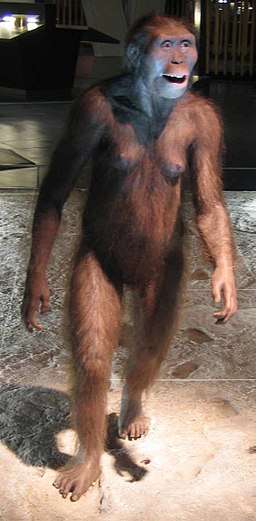
The brains of most species of Australopithecus were roughly 35% of the size of a modern human brain[42] with an endocranial volume average of 466 cc (28.4 cu in).[12] Although this is more than the average endocranial volume of chimpanzee brains at 360 cc (22 cu in)[12] the earliest australopiths (A. anamensis) appear to have been within the chimpanzee range,[39] whereas some later australopith specimens have a larger endocranial volume than that of some early Homo fossils.[12]
Most species of Australopithecus were diminutive and gracile, usually standing 1.2 to 1.4 m (3 ft 11 in to 4 ft 7 in) tall. It is possible that they exhibited a considerable degree of sexual dimorphism, males being larger than females.[43] In modern populations, males are on average a mere 15% larger than females, while in Australopithecus, males could be up to 50% larger than females by some estimates. However, the degree of sexual dimorphism is debated due to the fragmentary nature of australopith remains.[43]
According to A. Zihlman, Australopithecus body proportions closely resemble those of bonobos (Pan paniscus),[44] leading evolutionary biologist Jeremy Griffith to suggest that bonobos may be phenotypically similar to Australopithecus.[45] Furthermore, thermoregulatory models suggest that australopiths were fully hair covered, more like chimpanzees and bonobos, and unlike humans.[46]
The fossil record seems to indicate that Australopithecus is ancestral to Homo and modern humans. It was once assumed that large brain size had been a precursor to bipedalism, but the discovery of Australopithecus with a small brain but developed bipedality upset this theory. Nonetheless, it remains a matter of controversy as to how bipedalism first emerged. The advantages of bipedalism were that it left the hands free to grasp objects (e.g., carry food and young), and allowed the eyes to look over tall grasses for possible food sources or predators, but it is also argued that these advantages were not significant enough to cause the emergence of bipedalism. Earlier fossils, such as Orrorin tugenensis, indicate bipedalism around six million years ago, around the time of the split between humans and chimpanzees indicated by genetic studies. This suggests that erect, straight-legged walking originated as an adaptation to tree-dwelling.[47] Major changes to the pelvis and feet had already taken place before Australopithecus.[48] It was once thought that humans descended from a knuckle-walking ancestor,[49] but this is not well-supported.[50]
Australopithecines have thirty two teeth, like modern humans. Their molars were parallel, like those of great apes, and they had a slight pre-canine gap (diastema). Their canines were smaller, like modern humans, and with the teeth less interlocked than in previous hominins. In fact, in some australopithecines, the canines are shaped more like incisors.[51] The molars of Australopithicus fit together in much the same way those of humans do, with low crowns and four low, rounded cusps used for crushing. They have cutting edges on the crests.[51] However, australopiths generally evolved a larger postcanine dentition with thicker enamel.[52] Australopiths in general had thick enamel, like Homo, while other great apes have markedly thinner enamel.[51] Robust australopiths wore their molar surfaces down flat, unlike the more gracile species, who kept their crests.[51]
Diet
In a 1979 preliminary microwear study of Australopithecus fossil teeth, anthropologist Alan Walker theorized that robust australopiths ate predominantly fruit (frugivory).[53] Australopithecus species are thought to have eaten mainly fruit, vegetables, and tubers, and perhaps easy to catch animals such as small lizards. Much research has focused on a comparison between the South African species A. africanus and Paranthropus robustus. Early analyses of dental microwear in these two species showed, compared to P. robustus, A. africanus had fewer microwear features and more scratches as opposed to pits on its molar wear facets.[54] Microwear patterns on the cheek teeth of A. afarensis and A. anamensis indicate that A. afarensis predominantly ate fruits and leaves, whereas A. anamensis included grasses and seeds (in addition to fruits and leaves).[55] The thickening of enamel in australopiths may have been a response to eating more ground-bound foods such as tubers, nuts, and cereal grains with gritty dirt and other small particulates which would wear away enamel. Gracile australopiths had larger incisors, which indicates tearing food was important, perhaps eating scavenged meat. Nonetheless, the wearing patterns on the teeth support a largely herbivorous diet.[51]
In 1992, trace-element studies of the strontium/calcium ratios in robust australopith fossils suggested the possibility of animal consumption, as they did in 1994 using stable carbon isotopic analysis.[56] In 2005, fossil animal bones with butchery marks dating to 2.6 million years old were found at the site of Gona, Ethiopia. This implies meat consumption by at least one of three species of hominins occurring around that time: A. africanus, A. garhi, and/or P. aethiopicus.[57] In 2010, fossils of butchered animal bones dated 3.4 million years old were found in Ethiopia, close to regions where australopith fossils were found.[58]
Robust australopithecines (Paranthropus) had larger cheek teeth than gracile australopiths, possibly because robust australopithecines had more tough, fibrous plant material in their diets, whereas gracile australopiths ate more hard and brittle foods.[51] However, such divergence in chewing adaptations may instead have been a response to fallback food availability. In leaner times, robust and gracile australopithecines may have turned to different low-quality foods (fibrous plants for the former, and hard food for the latter), but in more bountiful times, they had more variable and overlapping diets.[59][60]
A study in 2018 found non-carious cervical lesions, caused by acid erosion, on the teeth of A. africanus, probably caused by consumption of acidic fruit.[61]
Technology
It was once thought that Australopithecus could not produce tools like Homo, but the discovery of A. garhi associated with large mammal bones bearing evidence of processing by stone tools showed this to not have been the case.[62][63] Discovered in 1994, this was the oldest evidence of manufacturing at the time[64][65] until the 2010 discovery of cut marks dating to 3.4 mya attributed to A. afarensis,[66] and the 2015 discovery of the Lomekwi culture from Lake Turkana dating to 3.3 mya possibly attributed to Kenyanthropus.[67] More stone tools dating to about 2.6 mya in Ledi-Geraru in the Afar Region were found in 2019, though these may be attributed to Homo.[68]
Notable specimens
- KT-12/H1, an A. bahrelghazali mandibular fragment, discovered 1995 in Sahara, Chad
- AL 129-1, an A. afarensis knee joint, discovered 1973 in Hadar, Ethiopia
- Karabo, a juvenile male A. sediba, discovered in South Africa
- Laetoli footprints, preserved hominin footprints in Tanzania
- Lucy, a 40%-complete skeleton of a female A. afarensis, discovered 1974 in Hadar, Ethiopia
- Selam, remains of a three-year-old A. afarensis female, discovered in Dikika, Ethiopia
- STS 5 (Mrs. Ples), the most complete skull of an A. africanus ever found in South Africa
- STS 14, remains of an A. africanus, discovered 1947 in Sterkfontein, South Africa
- STS 71, skull of an A. africanus, discovered 1947 in Sterkfontein, South Africa
- Taung Child, skull of a young A. africanus, discovered 1924 in Taung, South Africa
Gallery
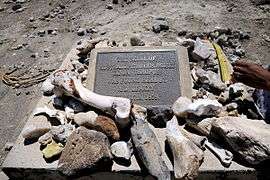 The spot where the first Australopithecus boisei was discovered in Tanzania.
The spot where the first Australopithecus boisei was discovered in Tanzania. Original skull of Mrs. Ples, a female A. africanus
Original skull of Mrs. Ples, a female A. africanus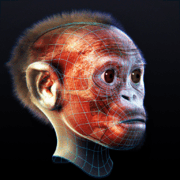 Taung Child by Cicero Moraes, Arc-Team, Antrocom NPO, Museum of the University of Padua.
Taung Child by Cicero Moraes, Arc-Team, Antrocom NPO, Museum of the University of Padua.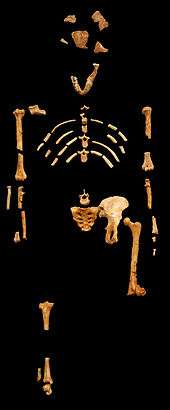 Cast of the skeleton of Lucy, an A. afarensis
Cast of the skeleton of Lucy, an A. afarensis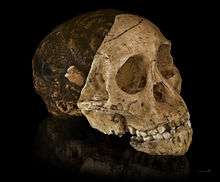 Skull of the Taung child
Skull of the Taung child
See also
- Aramis, Ethiopia
- Ardipithecus
- Chimpanzee–human last common ancestor
- Dawn of Humanity (2015 PBS film)
- Homo habilis
- Little Foot
- Life timeline
- List of fossil sites (with link directory)
- List of human evolution fossils (with images)
- Nature timeline
References
- Jones, Daniel (2003) [1917], Peter Roach; James Hartmann; Jane Setter (eds.), English Pronouncing Dictionary, Cambridge: Cambridge University Press, ISBN 978-3-12-539683-8
- Haile-Selassie, Y (27 October 2010). "Phylogeny of early Australopithecus: new fossil evidence from the Woranso-Mille (central Afar, Ethiopia)". Philosophical Transactions of the Royal Society B: Biological Sciences. 365 (1556): 3323–3331. doi:10.1098/rstb.2010.0064. PMC 2981958. PMID 20855306.
- Wood & Richmond 2000.
- Briggs & Crowther 2008, p. 124.
- Wood 2010.
- Cela-Conde & Ayala 2003.
- "Species … chart showing the time span during which fossils of each species have been found". Smithsonian National Museum of Natural History. Retrieved 2019-11-13.
- Asfaw, B; White, T; Lovejoy, O; Latimer, B; Simpson, S; Suwa, G (1999). "Australopithecus garhi: a new species of early hominid from Ethiopia". Science. 284 (5414): 629–35. Bibcode:1999Sci...284..629A. doi:10.1126/science.284.5414.629. PMID 10213683.
- "Exploring the fossil record: Australopithecus africanus". Bradshaw Foundation. Retrieved 2019-11-11.
- Berger, L. R.; de Ruiter, D. J.; Churchill, S. E.; Schmid, P.; Carlson, K. J.; Dirks, P. H. G. M.; Kibii, J. M. (2010). "Australopithecus sediba: a new species of Homo-like australopith from South Africa". Science. 328 (5975): 195–204. Bibcode:2010Sci...328..195B. CiteSeerX 10.1.1.729.7802. doi:10.1126/science.1184944. PMID 20378811.
- Toth, Nicholas and Schick, Kathy (2005). "African Origins" in The Human Past: World Prehistory and the Development of Human Societies (Editor: Chris Scarre). London: Thames and Hudson. Page 60. ISBN 0-500-28531-4
- Kimbel, W.H.; Villmoare, B. (5 July 2016). "From Australopithecus to Homo: the transition that wasn't". Philosophical Transactions of the Royal Society of London B: Biological Sciences. 371 (1698): 20150248. doi:10.1098/rstb.2015.0248. PMC 4920303. PMID 27298460.
- Reardon, Sara (2012-05-03). "The humanity switch: How one gene made us brainier". New Scientist. Retrieved 2020-03-06.
- Sporny, Michael; Guez-Haddad, Julia; Kreusch, Annett; Shakartzi, Sivan; Neznansky, Avi; Cross, Alice; Isupov, Michail N.; Qualmann, Britta; Kessels, Michael M.; Opatowsky, Yarden (June 2017). "Structural History of Human SRGAP2 Proteins". Molecular Biology and Evolution. 34 (6): 1463–1478. doi:10.1093/molbev/msx094. ISSN 0737-4038. PMC 5435084. PMID 28333212.
- Tocheri, Matthew W.; Orr, Caley M.; Jocofsky, Marc C.; Marzke, Mary W. (April 2008). "The evolutionary history of the hominin hand since the last common ancestor of Pan and Homo". Journal of Anatomy. 212 (4): 544–562. doi:10.1111/j.1469-7580.2008.00865.x. PMC 2409097. PMID 18380869.
- Lewin, Roger (1999). "The Australopithecines". Human Evolution: An Illustrated Introduction. Blackwell Science. pp. 112–113. ISBN 0632043091.
- Schwartz, Jeffrey H.; Tattersall, Ian (2015). "Defining the genus Homo". Science. 349 (931): 931–932. Bibcode:2015Sci...349..931S. doi:10.1126/science.aac6182. PMID 26315422.
- BRUXELLES L., CLARKE R. J., MAIRE R., ORTEGA R., et STRATFORD D. – 2014. - Stratigraphic analysis of the Sterkfontein StW 573 Australopithecus skeleton and implications for its age. Journal of Human Evolution,
- "New stratigraphic research makes Little Foot the oldest complete Australopithecus".
- Celia W. Dugger; John Noble Wilford (April 8, 2010). "New Hominid Species Discovered in South Africa". The New York Times.
- Cela-Conde, C. J.; Ayala, F. J. (2003). "Genera of the human lineage". Proceedings of the National Academy of Sciences. 100 (13): 7684–7689. Bibcode:2003PNAS..100.7684C. doi:10.1073/pnas.0832372100. PMC 164648. PMID 12794185.CS1 maint: ref=harv (link)
- Kimbel, William H. (2015), "The Species and Diversity of Australopiths", in Henke, Winfried; Tattersall, Ian (eds.), Handbook of Paleoanthropology, Springer Berlin Heidelberg, pp. 2071–2105, doi:10.1007/978-3-642-39979-4_50, ISBN 9783642399787
- Fleagle, John G. (2013-03-08). Primate Adaptation and Evolution. Academic Press. p. 364. ISBN 9780123786333.
- Schwarz, J.H. (2004). "Barking up the wrong ape--australopiths and the quest for chimpanzee characters in hominid fossils". Collegium Antropologicum. 28 Suppl 2: 87–101. PMID 15571084. S2CID 12944654.
- Cartmill, Matt (2018). "A sort of revolution: Systematics and physical anthropology in the 20th century". American Journal of Physical Anthropology. 165 (4): 677–687. doi:10.1002/ajpa.23321. hdl:2144/29233. PMID 29574829.
- Flegr, Jaroslav (2013-11-27). "Why Drosophila is not Drosophila any more, why it will be worse and what can be done about it?". Zootaxa. 3741 (2): 295–300. doi:10.11646/zootaxa.3741.2.8. ISSN 1175-5334. PMID 25112991.
- Pietrzak-Franger, Dr Monika; Schaff, Prof Dr Barbara; Voigts, Prof Dr Eckart (2014-02-28). Reflecting on Darwin. Ashgate Publishing, Ltd. p. 118. ISBN 9781472414090.
- Gribbin, John (2009-08-27). Science: A History: A History. Penguin Books Limited. ISBN 9780141042220.
- Hawks, John (2017-03-20). "The plot to kill Homo habilis". Medium. Retrieved 2019-03-24.
- Constantino, P.J. (2013). "The "Robust" Australopiths". www.nature.com. Nature Education Knowledge. Retrieved 20 November 2019.
- Wood, Bernard; Constantino, Paul (January 2007). "Paranthropus boisei: Fifty Years of Evidence and Analysis". American Journal of Physical Anthropology. Suppl 45 (6680): 106–132. doi:10.1002/ajpa.20732. PMID 18046746.
- Strait, David S.; Grine, Frederick E. (December 2004). "Inferring hominoid and early hominid phylogeny using craniodental characters: the role of fossil taxa". Journal of Human Evolution. 47 (6): 399–452. doi:10.1016/j.jhevol.2004.08.008. PMID 15566946.
- Ward, Carol V.; Hammind, Ashley S. (2016). "Australopithecus and Kin". The Nature Education Knowledge Project. Retrieved 2019-11-13.
- White, Tim D. (2002). "Chapter 24 Earliest Hominids". In Hartwig, Walter Carl (ed.). The Primate Fossil Record (Cambridge Studies in Biological and Evolutionary Anthropology). Cambridge University Press. ISBN 0-521-66315-6.
- Saylor, Beverly Z.; Scott, Gary; Levin, Naomi E.; Deino, Alan; Alene, Mulugeta; Ryan, Timothy M.; Melillo, Stephanie M.; Gibert, Luis; Haile-Selassie, Yohannes (2015). "New species from Ethiopia further expands Middle Pliocene hominin diversity". Nature. 521 (7553): 483–488. Bibcode:2015Natur.521..483H. doi:10.1038/nature14448. ISSN 1476-4687. PMID 26017448.
- Villmoare, Brian (2018-01-30). "Early Homo and the role of the genus in paleoanthropology". American Journal of Physical Anthropology. 165: 72–89. doi:10.1002/ajpa.23387. ISSN 0002-9483. PMID 29380889.
- "2 @BULLET Enhanced cognitive capacity as a contingent fact of hominid phylogeny". ResearchGate. Retrieved 2019-01-12.
- "Cowen: History of Life, 5th Edition - Student Companion Site". Wiley. p. 20/5. Retrieved 2019-01-12.
- Haile-Selassie, Yohannes; Melillo, Stephanie M.; Vazzana, Antonino; Benazzi, Stefano; Ryan, Timothy M. (2019). "A 3.8-million-year-old hominin cranium from Woranso-Mille, Ethiopia". Nature. 573 (7773): 214–219. Bibcode:2019Natur.573..214H. doi:10.1038/s41586-019-1513-8. hdl:11585/697577. PMID 31462770.
- David A. Raichlen; Adam D. Gordon; William E. H. Harcourt-Smith; Adam D. Foster; Wm. Randall Haas Jr (2010). Rosenberg, Karen (ed.). "Laetoli Footprints Preserve Earliest Direct Evidence of Human-Like Bipedal Biomechanics". PLOS ONE. 5 (3): e9769. Bibcode:2010PLoSO...5.9769R. doi:10.1371/journal.pone.0009769. PMC 2842428. PMID 20339543.
- Bower, Bruce (May 20, 2006). "Hybrid-Driven Evolution: Genomes show complexity of human-chimp split". Science News. 169 (20): 308–309. doi:10.2307/4019102. JSTOR 4019102.
- "Australopithecus afarensis". The Smithsonian Institution's Human Origins Program. 2010-01-25. Retrieved 2020-01-09.
- Beck, Roger B.; Linda Black; Larry S. Krieger; Phillip C. Naylor; Dahia Ibo Shabaka (1999). World History: Patterns of Interaction. McDougal Littell. ISBN 978-0-395-87274-1.
- Zihlman AL, Cronin JE, Cramer DL, Sarich VM (1978). "Pygmy chimpanzee as a possible prototype for the common ancestor of humans, chimpanzees and gorillas". Nature. 275 (5682): 744–6. Bibcode:1978Natur.275..744Z. doi:10.1038/275744a0. PMID 703839.
- Griffith, Jeremy (2013). Freedom Book 1. Part 8:4G. WTM Publishing & Communications. ISBN 978-1-74129-011-0. Retrieved 28 March 2013.
- David-Barrett, T.; Dunbar, R.I.M. (2016). "Bipedality and Hair-loss Revisited: The Impact of Altitude and Activity Scheduling". Journal of Human Evolution. 94: 72–82. doi:10.1016/j.jhevol.2016.02.006. PMC 4874949. PMID 27178459.
- Thorpe, SK; Holder, RL; Crompton, RH. (2007). "Origin of human bipedalism as an adaptation for locomotion on flexible branches". Science. 316 (5829): 1328–31. Bibcode:2007Sci...316.1328T. doi:10.1126/science.1140799. PMID 17540902.
- Lovejoy, C. O. (1988). "Evolution of Human walking". Scientific American. 259 (5): 82–89. Bibcode:1988SciAm.259e.118L. doi:10.1038/scientificamerican1188-118. PMID 3212438.
- Richmond, BG; Begun, DR; Strait, DS (2001). "Origin of human bipedalism: The knuckle-walking hypothesis revisited". American Journal of Physical Anthropology. Suppl 33: 70–105. doi:10.1002/ajpa.10019. PMID 11786992.
- Kivell, TL; Schmitt, D. (Aug 2009). "Independent evolution of knuckle-walking in African apes shows that humans did not evolve from a knuckle-walking ancestor". Proceedings of the National Academy of Sciences of the United States of America. 106 (34): 14241–6. Bibcode:2009PNAS..10614241K. doi:10.1073/pnas.0901280106. PMC 2732797. PMID 19667206.
- Kay, R.F., 1985, 'DENTAL EVIDENCE FOR THE DIET OF AUSTRALOPITHECUS', Annual Review of Anthropology, 14, pp. 315-341.
- McHenry, H. M. (2009). "Human Evolution". In Michael Ruse; Joseph Travis (eds.). Evolution: The First Four Billion Years. Cambridge, Massachusetts: The Belknap Press of Harvard University Press. pp. 261–265. ISBN 978-0-674-03175-3.
- Billings, Tom. "Humanity's Evolutionary Prehistoric Diet and Ape Diets--continued, Part D)". Archived from the original on 8 January 2007. Retrieved 2007-01-06.
- Grine FE (1986). "Dental evidence for dietary differences in Australopithecus and Paranthropus - a quantitative-analysis of permanent molar microwear". Journal of Human Evolution. 15 (8): 783–822. doi:10.1016/S0047-2484(86)80010-0.
- Martínez, L.; Estebaranz-Sánchez, F.; Galbany, J.; Pérez-Pérez, A. (2016). "Testing Dietary Hypotheses of East African Hominines Using Buccal Dental Microwear Data". PLOS ONE. 11 (11): 1–25. doi:10.1371/journal.pone.0165447. PMC 5112956. PMID 27851745.
- Billings, Tom. "Comparative Anatomy and Physiology Brought Up to Date--continued, Part 3B)". Archived from the original on 15 December 2006. Retrieved 2007-01-06.
- Nature. "Evidence for Meat-Eating by Early Humans".
- Nature (2010). "Butchering dinner 3.4 million years ago". Nature. doi:10.1038/news.2010.399.
- Ungar, P. S.; Grine, F. E.; Teaford, M. F. (2008). "Dental Microwear and Diet of the Plio-Pleistocene Hominin Paranthropus boisei". PLOS ONE. 3 (4): e2044. Bibcode:2008PLoSO...3.2044U. doi:10.1371/journal.pone.0002044. PMC 2315797. PMID 18446200.
- Scott RS, Ungar PS, Bergstrom TS, Brown CA, Grine FE, Teaford MF, Walker A (2005). "Dental microwear texture analysis shows within-species diet variability in fossil hominins". Nature. 436 (7051): 693–695. Bibcode:2005Natur.436..693S. doi:10.1038/nature03822. PMID 16079844.
- Towle, Ian; Irish, Joel D.; Elliott, Marina; De Groote, Isabelle (2018-09-01). "Root grooves on two adjacent anterior teeth of Australopithecus africanus" (PDF). International Journal of Paleopathology. 22: 163–167. doi:10.1016/j.ijpp.2018.02.004. ISSN 1879-9817. PMID 30126662.
- Asfaw, Berhane; White, Tim; Lovejoy, Owen; Latimer, Bruce; Simpson, Scott; Suwa, Gen (23 April 1999). "Australopithecus garhi: A New Species of Early Hominid from Ethiopia". Science. 284 (5414): 629–635. Bibcode:1999Sci...284..629A. doi:10.1126/science.284.5414.629. PMID 10213683.
- de Heinzelin, Jean; Clark, J. Desmond; White, Tim; Hart, William; Renne, Paul; WoldeGabriel, Giday; Beyene, Yonas; Vrba, Elisabeth (23 April 1999). "Environment and Behavior of 2.5-Million-Year-Old Bouri Hominids". Science. 284 (5414): 625–629. Bibcode:1999Sci...284..625D. doi:10.1126/science.284.5414.625. PMID 10213682.
- Semaw, S.; Renne, P.; Harris, J. W. K. (1997). "2.5-million-year-old stone tools from Gona, Ethiopia". Nature. 385 (6614): 333–336. doi:10.1038/385333a0. PMID 9002516.
- Semaw, S.; Rogers, M. J.; Quade, J.; et al. (2003). "2.6-Million-year-old stone tools and associated bones from OGS-6 and OGS-7, Gona, Afar, Ethiopia". Journal of Human Evolution. 45 (2): 169–177. doi:10.1016/s0047-2484(03)00093-9. PMID 14529651.
- McPherron, S. P.; Alemseged, Z.; Marean, C. W.; et al. (2010). "Evidence for stone-tool-assisted consumption of animal tissues before 3.39 million years ago at Dikika, Ethiopia". Nature. 466 (7308): 857–860. doi:10.1038/nature09248. PMID 20703305.
- Harmand, S.; Lewis, J. E.; Feibel, C. S.; et al. (2015). "3.3-million-year-old stone tools from Lomekwi 3, West Turkana, Kenya". Nature. 521 (7552): 310–315. doi:10.1038/nature14464. PMID 25993961.
- Braun, D. R.; Aldeias, V.; Archer, W.; et al. (2019). "Earliest known Oldowan artifacts at >2.58 Ma from Ledi-Geraru, Ethiopia, highlight early technological diversity". Proceedings of the National Academy of Sciences. 116 (24): 11712–11717. doi:10.1073/pnas.1820177116. PMID 31160451.
Further reading
- Barraclough, G. (1989). Stone, N. (ed.). Atlas of World History (3rd ed.). Times Books Limited. ISBN 978-0-7230-0304-5..
- Leakey, Richard (1994). The Origins of Human Kind. New York: BasicBooks. ISBN 978-0-465-03135-1..
- White, Tim D.; WoldeGabriel, Giday; Asfaw, Berhane; Ambrose, S; Beyene, Y; Bernor, RL; Boisserie, JR; Currie, B; Gilbert, H; Haile-Selassie, Y; Hart, WK; Hlusko, LJ; Howell, FC; Kono, RT; Lehmann, T; Louchart, A; Lovejoy, CO; Renne, PR; Saegusa, H; Vrba, ES; Wesselman, H; Suwa, G (2006). "Asa Issie, Aramis and the Origin of Australopithecus". Nature. 440 (7086): 883–889. Bibcode:2006Natur.440..883W. doi:10.1038/nature04629. PMID 16612373..
- Gibbons, Ann (2006). The first human. New York: Doubleday. p. 306. ISBN 978-0385512268.
- Reader, John (2011). Missing links: in search of human origins. New York: Oxford University Press. p. 538. ISBN 978-0-19-927685-1.
- Tattersall, Ian (2012). Masters of the Planet, the search for our human origins. Palgrave-Macmillan. pp. 1–79. ISBN 978-0-230-10875-2.
External links
| Wikibooks has a book on the topic of: Introduction to Paleoanthropology |
| Wikimedia Commons has media related to Australopithecus. |
| Wikispecies has information related to Australopithecus |
- Metadata and Virtual Models of Australopithecus Fossils on NESPOS
- The Age of Australopithecus - Interactive Map of the Evolution of Australopithecus
- Human Timeline (Interactive) – Smithsonian, National Museum of Natural History (August 2016).